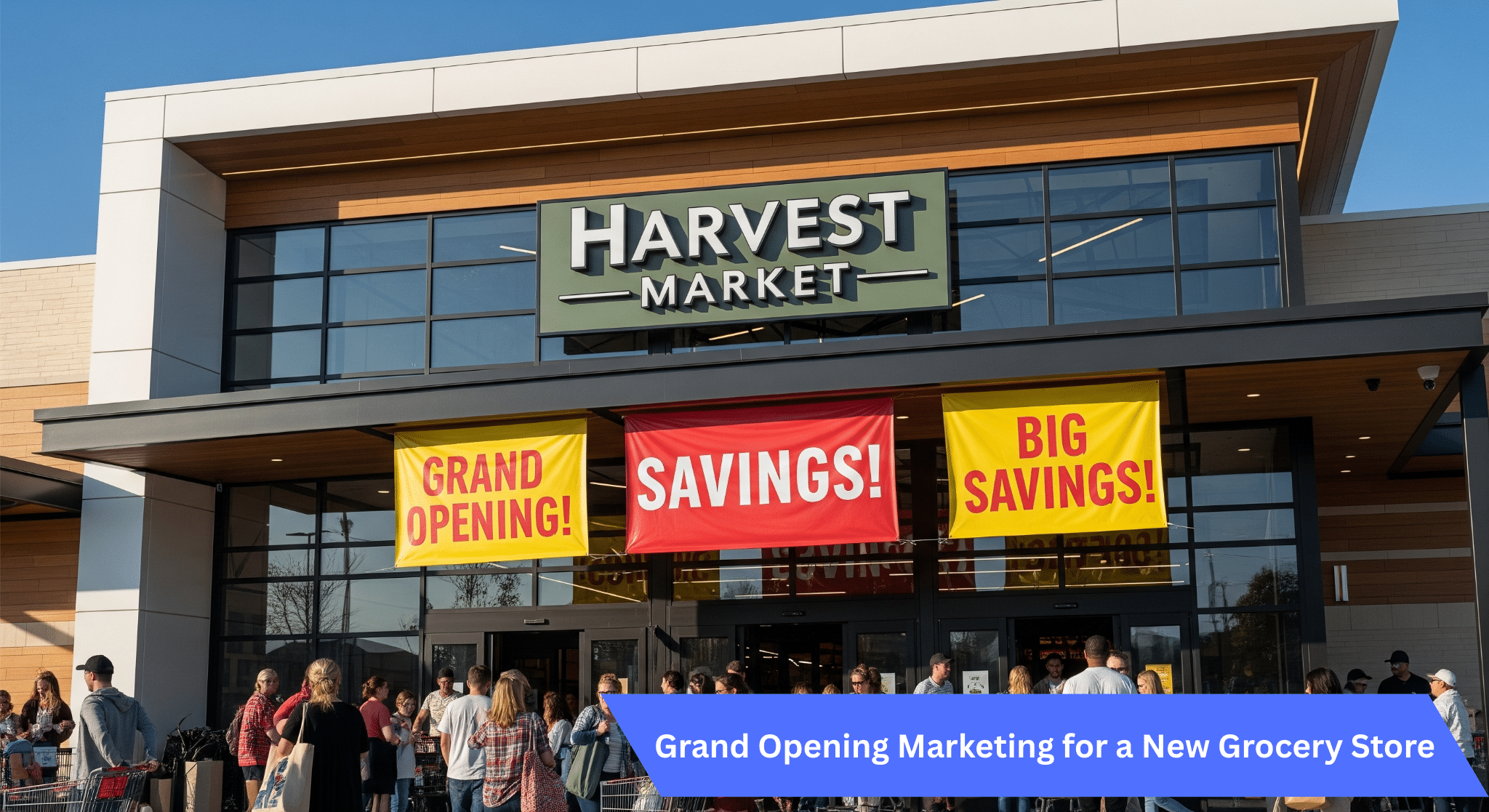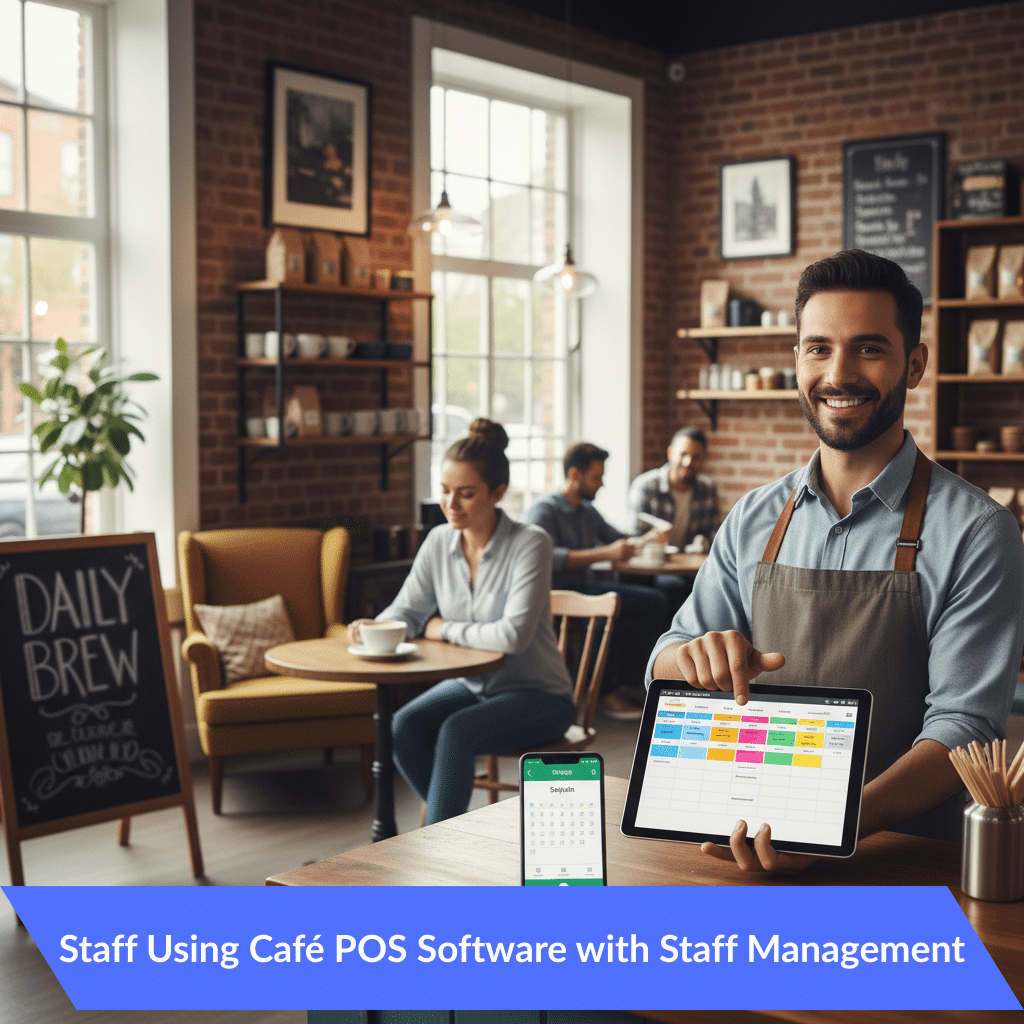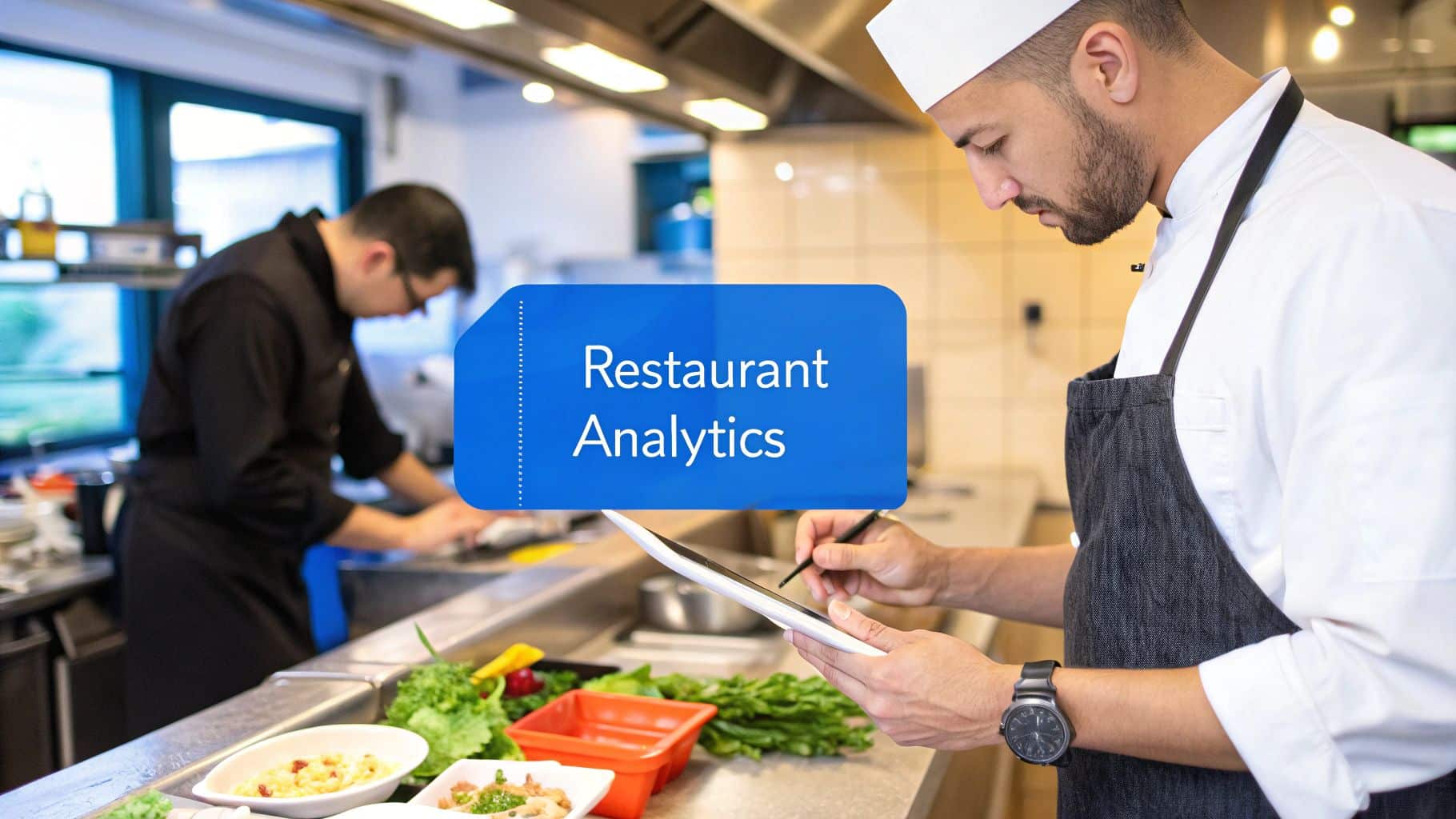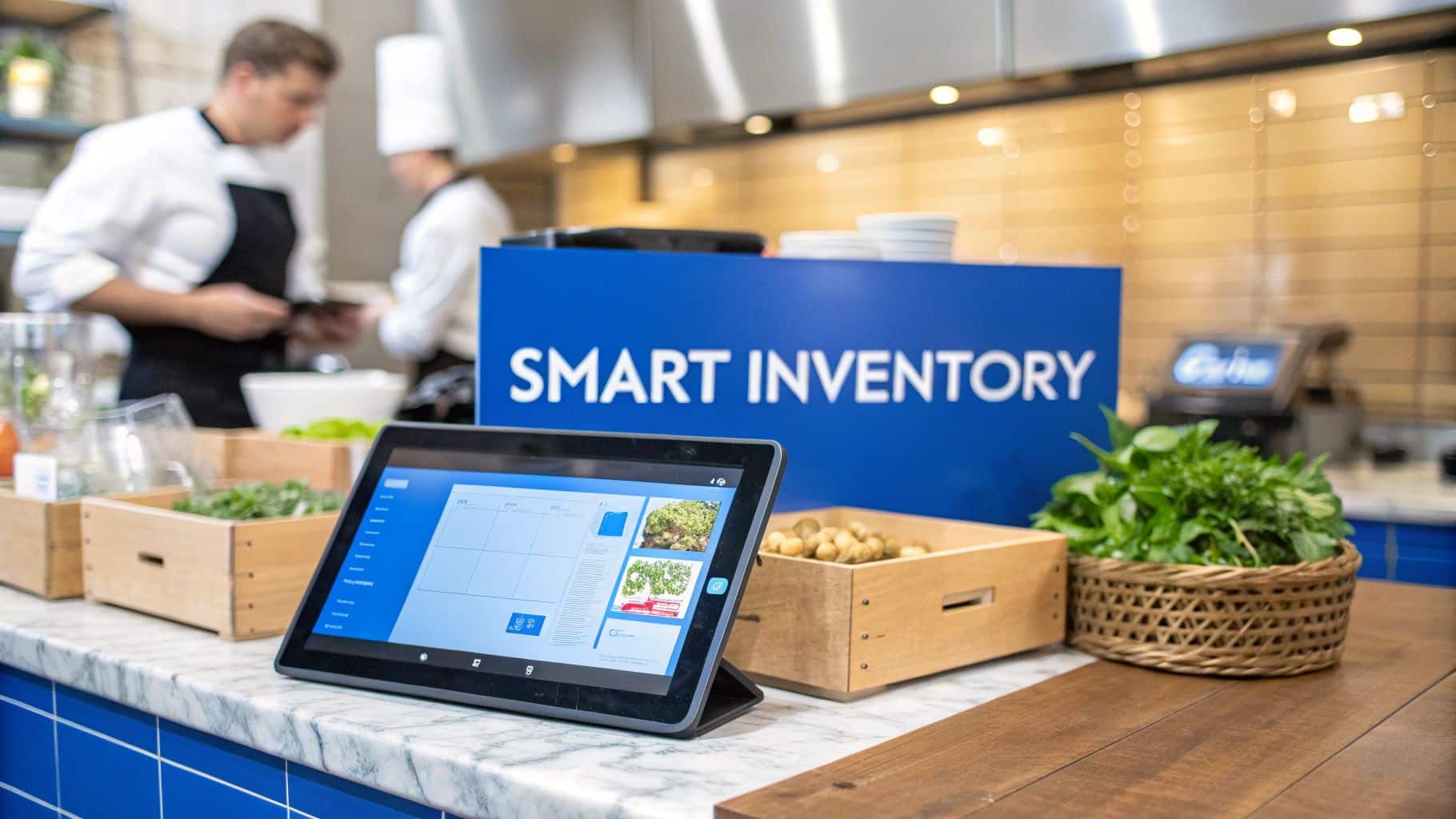Opening a grocery store is an exciting venture, but it takes more than just filling aisles with products to succeed. The true challenge is mastering effective marketing for a new grocery store so that shoppers not only discover your business but also form lasting connections that keep them coming back. A solid marketing strategy helps create visibility, establish trust, and build loyalty in a competitive market where large chains and neighborhood shops compete for the same customers.
Marketing for a new grocery store requires a combination of traditional outreach, community involvement, and innovative digital campaigns. From grand opening promotions that create buzz to long-term retention strategies like loyalty programs, every effort must be aligned to attract attention while fostering customer engagement. The most successful grocery stores view marketing as an ongoing process, one that evolves with seasonal demands, customer behavior, and market trends.
This article breaks down actionable strategies that any grocery store can implement to increase foot traffic, generate excitement, and establish a recognizable brand. You’ll discover how to plan powerful grand openings, leverage local and digital advertising, build customer loyalty, and create long-term growth strategies. Let’s dive into the essential marketing techniques that can transform your grocery store into the community’s preferred shopping destination.
Table of Contents
- Grand Opening Promotions and Community Buzz
- Local Advertising and Digital Outreach
- Customer Engagement and Loyalty Programs
- Seasonal Promotions and In-Store Campaigns
- Customer Retention and Long-Term Growth
- Why Biyo POS Supports Your Grocery Store Marketing
- FAQ
Grand Opening Promotions and Community Buzz
The launch of a grocery store sets the tone for how customers perceive your brand. A carefully designed grand opening event creates excitement, spreads awareness, and encourages first-time shoppers to experience your store. The right approach ensures your business is not just noticed but remembered.
Creating Hype with Grand Opening Promotions
Grand opening promotions should be designed to make your store feel like the “must-visit” destination in town. Consider offering exclusive one-day deals, giveaways, or “buy one, get one free” offers to generate urgency. For example, giving away reusable branded tote bags with every purchase not only attracts customers but also extends your brand presence into their everyday lives. Another effective tactic is offering promotional discounts on staple items like bread, milk, or eggs, which encourages trial shopping and builds a perception of affordability.
To build anticipation, begin marketing at least three to four weeks before the opening. Use social media teasers, flyers, and community bulletin boards to inform residents of what’s coming. You could also share behind-the-scenes posts of shelf stocking, vendor partnerships, or your team preparing for the big day. These create a sense of transparency and excitement, giving people a reason to follow your progress leading up to launch.
Finally, consider offering early-bird specials for the first set of customers who walk through the door. For instance, rewarding the first 100 shoppers with discount vouchers creates urgency and exclusivity. These shoppers will often share their experience online or with friends, providing free word-of-mouth marketing that extends the buzz beyond the event itself.
Leveraging Community Events to Build Trust
Community events position your store as more than a business—it becomes a trusted gathering space. Hosting ribbon-cutting ceremonies with local leaders, live performances, or children’s activities encourages families to attend together. When people associate your grocery store with positive community experiences, they are more likely to return even outside of promotional periods.
Collaborating with local organizations is another proven approach. For example, donating a percentage of grand opening sales to a nearby food bank demonstrates commitment to community welfare. Schools and churches often welcome partnerships for fundraisers, and these collaborations extend your reach to highly engaged audiences. By investing in these relationships, your store earns goodwill that advertising dollars alone cannot buy.
Additionally, engaging customers through contests or raffles at community events makes the experience interactive. Simple activities such as a “guess the weight of the pumpkin” contest or recipe demonstrations with local chefs create memorable moments. These initiatives show that your store is not just a retailer but a partner in the community’s daily life.
Influencer Partnerships to Expand Reach
Influencer marketing may seem more suited to fashion or tech brands, but it’s increasingly effective in food retail marketing strategy. Local food bloggers, nutritionists, or community lifestyle influencers often have highly engaged audiences who value their recommendations. Inviting them to preview your store before opening and encouraging them to share their experiences can extend your reach far beyond traditional advertising.
For instance, a local influencer could showcase your fresh produce section, unique imported items, or specialty bakery on Instagram stories. This creates authentic endorsements that potential customers trust more than brand-generated ads. Even micro-influencers with just a few thousand followers can have outsized impact in local markets because their audiences are highly concentrated geographically.
To maximize these partnerships, co-create campaigns that include giveaways, coupon codes, or live-streamed events. This allows influencers’ audiences to engage directly with your brand while driving them to physically visit the store. Over time, influencer partnerships can also highlight seasonal promotions or in-store sampling events, creating recurring excitement.
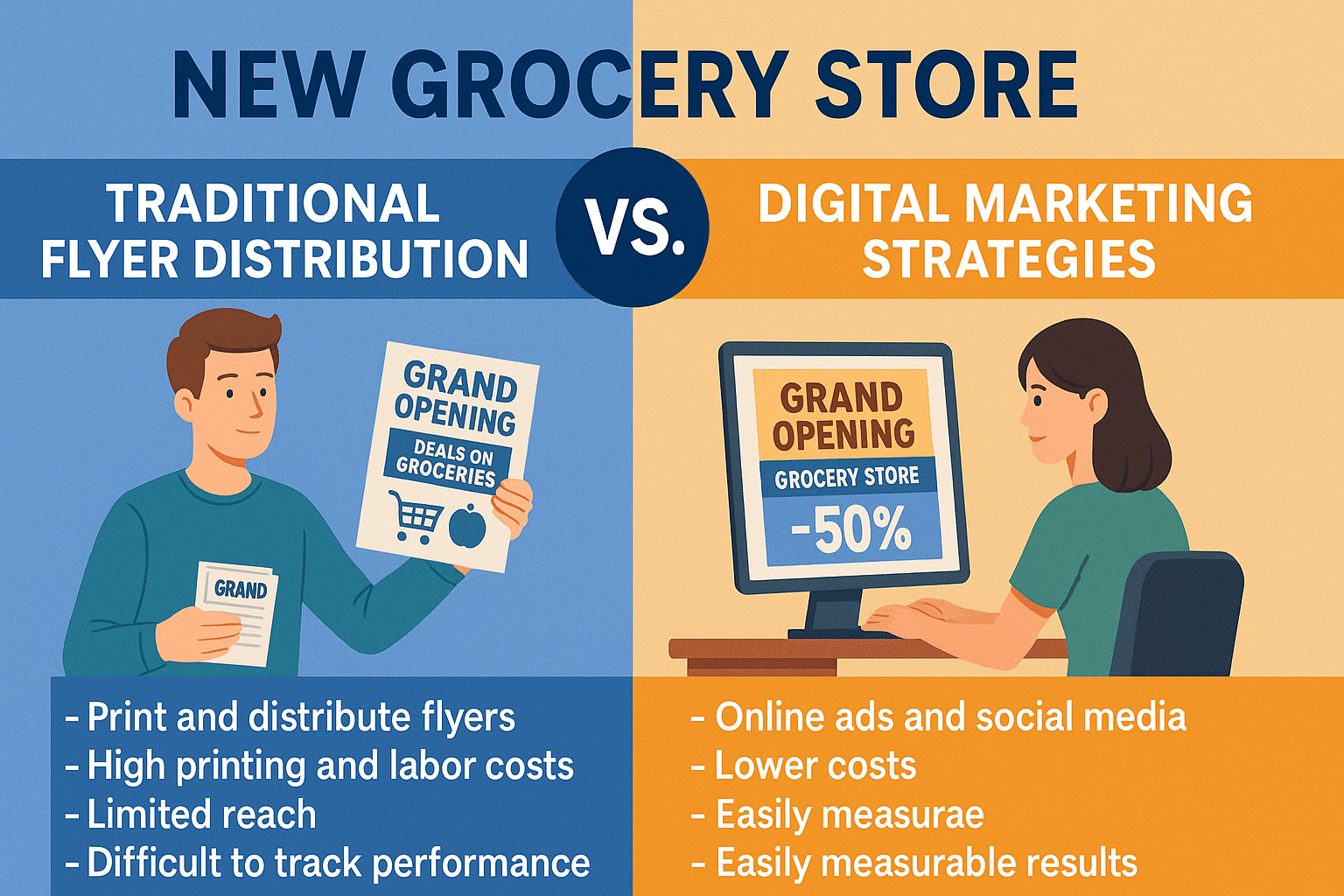
Local Advertising and Digital Outreach
Marketing for a new grocery store should balance traditional visibility with modern digital outreach. While many customers discover businesses online, local advertising continues to play a vital role in small communities. A multi-channel approach ensures you reach people wherever they are—whether browsing social media or reading the local newspaper.
Local Advertising That Still Works
Despite the digital shift, offline advertising remains an effective way to capture attention, especially among older demographics. Flyers distributed in residential areas, posters in community centers, and newspaper inserts can deliver weekly deals or highlight special promotions. Grocery flyers have a proven track record in retail because shoppers often keep them handy while planning their shopping lists.
Billboard placements along busy roads also generate brand visibility, particularly when highlighting seasonal promotions. A clear message such as “Grand Opening: Fresh Produce at Everyday Low Prices” paired with attractive visuals can create lasting impressions. Likewise, sponsoring local radio spots during morning commute hours ensures your message reaches a captive audience.
To improve the effectiveness of local advertising, integrate coupons or QR codes that drive customers toward digital platforms. This hybrid approach bridges the gap between offline and online marketing while providing measurable results. By tracking redemptions, you gain valuable insight into which offline channels are delivering real conversions.
Social Media Marketing for Brand Awareness
Social media platforms are powerful tools for building awareness and engagement. Facebook remains popular among families and older audiences, while Instagram and TikTok are effective for younger shoppers. Posting consistent, high-quality content—such as recipe tips, behind-the-scenes videos, or weekly product highlights—helps your grocery store stand out in crowded feeds.
Story-driven content works particularly well. For example, showcasing the journey of locally sourced produce from farm to shelf creates authenticity while promoting community-based grocery marketing. Interactive posts like polls or “vote for the next product we stock” create opportunities for direct engagement, making shoppers feel part of your decision-making process.
Paid social media campaigns allow you to target specific demographics. With geo-targeted ads, you can reach people within a few miles of your location and promote grand opening promotions, loyalty programs, or seasonal discounts. This level of precision ensures your marketing dollars are used efficiently, attracting customers most likely to visit.
Digital Marketing and SEO Strategy
Digital marketing expands your store’s reach beyond immediate geography and ensures visibility in search engines. An SEO strategy is critical for appearing when people search for terms like “grocery store near me” or “organic supermarket in [city].” Optimizing your website with location-based keywords, fast-loading pages, and mobile-friendly design increases your chances of ranking higher in Google search results.
Email campaigns are another essential tool for ongoing digital outreach. Sending newsletters with product spotlights, seasonal promotions, and exclusive coupon campaigns keeps your store top of mind. Personalizing these emails with customer names or purchase history data boosts open rates and strengthens relationships.
In addition, running Google Ads or social retargeting campaigns ensures you remain visible to people who have already shown interest in your store. For example, if someone visits your website but doesn’t subscribe to your newsletter, a retargeting ad offering a discount may bring them back. Combining SEO, paid ads, and email builds a comprehensive digital marketing strategy that complements your offline efforts.
Customer Engagement and Loyalty Programs
Once you’ve attracted customers, the challenge is keeping them engaged and loyal. Customer engagement strategies and loyalty programs create emotional connections that turn first-time shoppers into repeat buyers. This is where marketing for a new grocery store evolves from acquisition into retention and growth.
Building Strong Loyalty Programs
Loyalty programs provide customers with reasons to return regularly. Shoppers are more likely to stay loyal when they know repeat purchases lead to rewards. Points-based systems, tiered memberships, or exclusive discounts for members are all proven models. For example, a loyalty card offering “Earn 1 point per dollar spent” that converts into store credits provides tangible value over time.
Digital loyalty platforms integrated with your POS system streamline participation. Customers can track points, redeem rewards, and receive personalized offers via apps or email. These programs also supply valuable customer data that informs future marketing campaigns, such as identifying which products are most popular among your regular shoppers.
To make loyalty programs truly effective, focus on personalization. If you notice that a family regularly purchases gluten-free items, offering discounts on related products demonstrates attentiveness to their needs. Personalized incentives make shoppers feel valued, increasing retention and satisfaction.
Encouraging Referral Programs
Referral programs transform satisfied customers into ambassadors who attract new shoppers. By offering rewards like discounts, store credits, or free products for referrals, you encourage existing customers to bring friends and family. For instance, “Give $5, Get $5” programs create win-win scenarios for both the referrer and the new customer.
These programs work especially well in tight-knit communities where word-of-mouth carries significant weight. People trust personal recommendations far more than traditional ads, and a well-structured referral program amplifies this natural behavior. Promoting referral incentives through email campaigns and social media can expand reach exponentially.
Referral tracking through digital platforms ensures fairness and transparency. Customers can see exactly when their referrals convert, and you can measure campaign success in real time. This data-driven approach allows you to refine incentives and maximize effectiveness over time.
Hosting Community Engagement Activities
Hosting community events within your grocery store builds stronger relationships with customers. Cooking classes, nutrition workshops, and children’s activities provide value beyond transactions, positioning your store as a hub for education and entertainment. These experiences foster loyalty because shoppers associate your brand with positive, enriching moments.
In-store sampling is another classic but highly effective engagement activity. Offering free tastings of seasonal products or new arrivals increases purchase likelihood while giving customers an enjoyable shopping experience. For example, sampling holiday chocolates in December or fresh fruit in summer drives immediate sales while promoting new product categories.
Engaging customers in store decisions further strengthens loyalty. Running polls on social media or in-store kiosks to let customers vote on which products to stock gives them a voice. When customers feel their input matters, they become emotionally invested in your store’s success.
Seasonal Promotions and In-Store Campaigns
Adapting your marketing for a new grocery store to seasonal trends ensures your brand remains relevant year-round. Customers’ needs change with holidays, weather, and cultural events, so aligning your promotions with these cycles can significantly boost engagement and sales.
Holiday-Themed Campaigns
Holidays provide built-in opportunities to connect with customers. For instance, offering “Thanksgiving Dinner Packages” that bundle turkey, stuffing, and dessert simplifies holiday prep for families. These pre-assembled kits not only increase average transaction values but also position your store as a convenient one-stop solution during busy times.
Holiday-themed displays enhance the in-store experience. Colorful signage, festive décor, and seasonal music make shopping enjoyable and memorable. Pairing these visuals with digital marketing—such as social media contests encouraging customers to share their holiday recipes—amplifies reach and engagement.
Timing is critical in seasonal marketing. Launching campaigns early ensures you capture early planners, while last-minute discounts appeal to procrastinators. By catering to both groups, you maximize sales throughout the holiday shopping period.
In-Store Sampling and Experiential Marketing
Experiential marketing transforms grocery shopping from a routine task into an engaging experience. In-store sampling events allow customers to taste new or seasonal products, which often leads to impulse purchases. Sampling also strengthens vendor partnerships, as brands are eager to showcase their products in live settings.
Beyond sampling, immersive events can create lasting impressions. Hosting a “Mediterranean Week” with recipe cards, themed tastings, and cooking demonstrations turns your store into a cultural experience. These events differentiate your store from competitors who only rely on discounts to attract traffic.
Promoting sampling events through local advertising and digital outreach ensures maximum turnout. Posting live updates on social media, such as short videos of customers enjoying samples, extends the experience to wider audiences and encourages more visits in the future.
Cross-Promotions with Local Businesses
Cross-promotions allow you to partner with local businesses for mutual benefit. For example, collaborating with a nearby coffee shop could mean offering discounts on pastries for customers who present your grocery store receipt. In return, you could distribute coupons for their café within your store. This approach helps both businesses reach new audiences while creating added value for customers.
Schools, gyms, and local farmers are excellent partners for cross-promotions. A gym partnership, for instance, could focus on promoting healthy snacks or fresh produce. These collaborations reinforce your store’s role in promoting healthier lifestyles while attracting customers who may not have considered your grocery store before.
Sharing marketing costs is another benefit of cross-promotions. By pooling advertising budgets for flyers, social media campaigns, or local events, you reduce expenses while gaining exposure across multiple customer bases. This makes cross-promotions a sustainable, cost-efficient growth strategy.
Customer Retention and Long-Term Growth
Sustaining success in grocery retail requires more than attracting new customers. Retaining them through personalized engagement and continuous innovation is key to long-term profitability. Strong customer retention strategies ensure consistent sales and build resilience against competition.
Personalized Email Campaigns
Email remains one of the most cost-effective tools for retention. By tailoring messages to customers’ past purchases, you provide highly relevant offers. For example, if a shopper frequently buys plant-based products, sending them an email featuring new vegan snacks or recipes feels personal and thoughtful. This type of communication increases both engagement and sales.
Beyond promotions, email campaigns can offer valuable content. Sharing cooking tips, healthy meal ideas, or community updates adds value that keeps customers opening your emails week after week. This approach turns your store into a trusted source of information, not just a retailer.
Tracking performance metrics such as open rates, click-throughs, and redemptions ensures your campaigns remain effective. Over time, analyzing these insights helps you refine subject lines, sending times, and content to maximize impact.
Enhancing Customer Retention Through Technology
Technology plays a crucial role in modern grocery marketing. Advanced POS systems like Biyo POS integrate loyalty tracking, customer profiles, and purchase history into one platform. This allows you to create data-driven campaigns that respond directly to customer behavior, such as personalized discounts or birthday offers.
Mobile apps are another valuable tool. Offering digital loyalty cards, push notifications about weekly specials, or easy coupon redemptions through an app provides convenience. Customers appreciate brands that simplify their shopping experiences, and convenience drives loyalty.
SMS campaigns can also be effective for flash promotions or urgent updates, such as announcing same-day discounts on perishable items. By delivering timely, relevant information directly to customers’ phones, you stay connected and top-of-mind even outside the store.
Building Brand Awareness for Growth
Long-term grocery business growth depends on brand awareness. Beyond individual campaigns, your brand identity—logo, colors, messaging—must consistently reflect your values. Shoppers remember and trust brands that maintain authenticity and reliability over time. This means being consistent across in-store signage, digital platforms, and community outreach.
Customer testimonials and reviews are another way to strengthen awareness. Encouraging shoppers to leave positive reviews online or share experiences on social media creates organic marketing. New customers often rely on these reviews before trying a store for the first time, making them a powerful growth driver.
Finally, investing in continuous feedback loops ensures your brand evolves with customer needs. Surveys, suggestion boxes, or digital polls demonstrate that you listen. Responding to feedback builds trust and fosters loyalty, ensuring your brand remains relevant and competitive in a crowded marketplace.
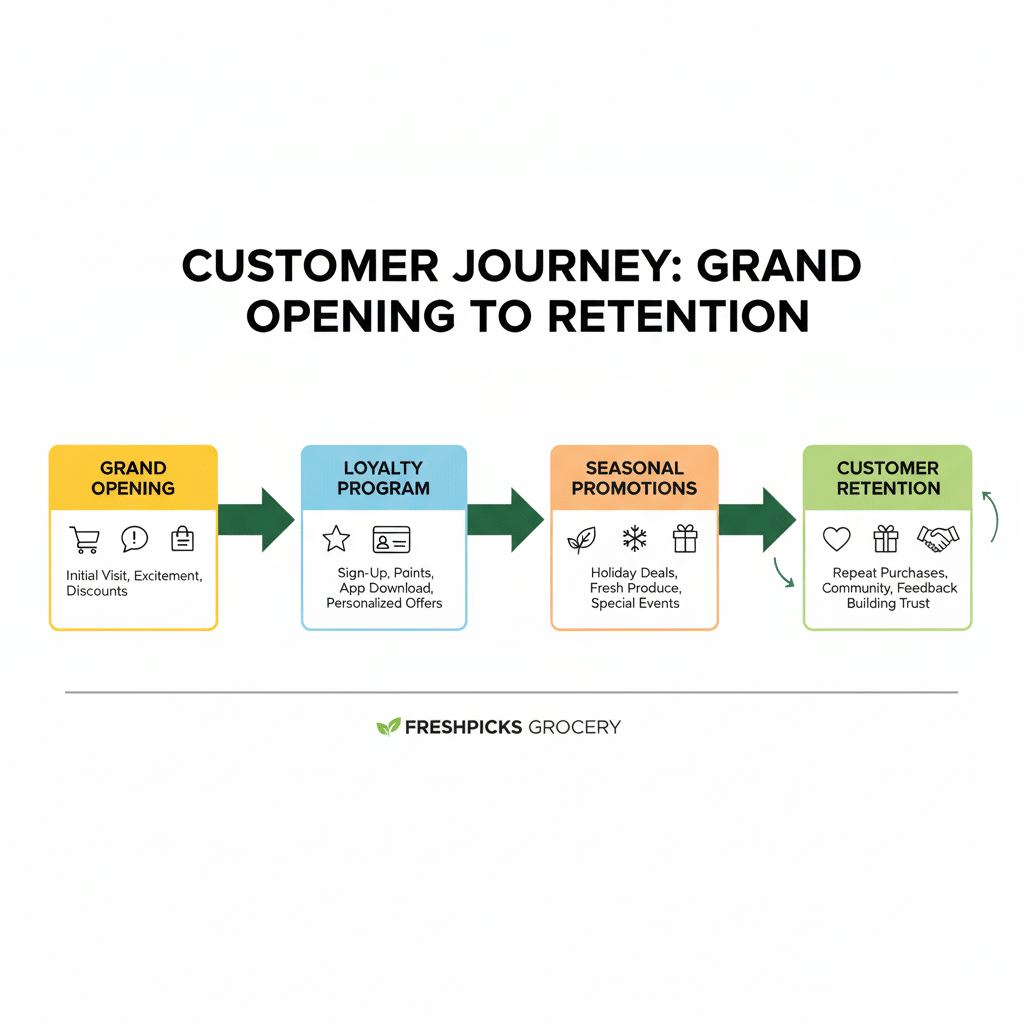
Why Biyo POS Supports Your Grocery Store Marketing
Executing all these strategies becomes much easier with the right technology. Biyo POS provides grocery stores with powerful tools for running loyalty programs, managing referral campaigns, and tracking promotional discounts. Its integrated dashboard offers customer data insights that help you refine your marketing efforts while keeping operations smooth.
With features like in-store sampling support, coupon tracking, and seamless digital marketing integration, Biyo POS enables you to align promotions across multiple channels. By simplifying both marketing and operational tasks, it frees you to focus on building strong community connections and expanding your customer base. Ready to take your grocery store marketing to the next level? Sign up today at this link and unlock modern retail growth solutions.
FAQ
How do I attract customers to a new grocery store?
Attract customers through grand opening promotions, community events, and social media marketing. Use coupon campaigns and flyer distribution to reach local audiences while creating digital buzz with influencer partnerships and targeted ads.
What is the most effective digital marketing strategy for grocery stores?
The most effective strategy combines SEO optimization, social media advertising, and personalized email campaigns. Together, these tools ensure your store ranks in local searches while maintaining strong customer engagement through tailored communications.
Why are loyalty programs important for grocery marketing?
Loyalty programs encourage repeat visits and provide valuable insights into shopping behavior. By rewarding purchases and personalizing offers, you increase retention and build stronger customer relationships that drive long-term sales.
How can seasonal promotions boost sales?
Seasonal promotions align with customer needs during holidays and cultural events. Bundled meal kits, themed displays, and time-sensitive discounts increase average spending while keeping your store relevant throughout the year.
What role does technology play in grocery store marketing?
Technology simplifies campaign management and enables personalization. POS systems, loyalty apps, and digital communication tools streamline operations while making it easier to run data-driven, targeted marketing campaigns that improve retention and growth.
